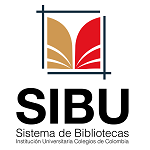SIBU - SISTEMAS DE BIBLIOTECAS UNICOC
Caracterización de biotipo periodontal en pacientes de las clínicas de ortodoncia de unicoc - sede centro bogotá. Fase I.
por Alvira Iriarte, Ana María ; Álvarez, Diana Fernanda
; Álvarez, Diana Fernanda ; Chaves Cabrera, Rodrigo
; Chaves Cabrera, Rodrigo .
.
Editor: Bogotá (Colombia); Institución Universitaria Colegios de Colombia - UNICOC; 2017Descripción: 2 CD.Tema(s): Odontología / Periodoncia - Tesis y Disertaciones Academicas| Tipo de ítem | Ubicación | Signatura topográfica | Estado | Fecha de vencimiento | Código de barras | Reserva de ejemplares |
|---|---|---|---|---|---|---|
 Trabajo de Grado Trabajo de Grado |
Bogotá (Dr. David Ordóñez Rueda) - Campus Norte
Campus Norte Biblioteca de la Institución Universitaria Colegios de Colombia |
T.O.Pe.0078 (Navegar estantería) | Disponible | 20171TOPe0078 |
Incluye tabla de contenido y referencias bibliográficas.
Asesor científico: Dra. Sandra Moscoso, Asesor metodológico: Dr. Camilo Novoa.
RESÚMEN
Objetivo general: identificar el biotipo periodontal de los pacientes que inician tratamiento de ortodoncia en las clínicas de UNICOC sede centro Bogotá, durante el periodo enero a abril de 2017.
Materiales y métodos: investigación observacional descriptiva transversal, con una muestra de 25 pacientes seleccionados por conveniencia y en los que se realizó examen clínico en los incisivos centrales inferiores 31 y 41, utilizando una sonda periodontal (Hu-Friedy Carolina del Norte), para la determinación del biotipo periodontal mediante la técnica de transparencia de la sonda y el ancho de la encía queratinizada. Con tomografías computarizadas, a 3 y 6 mm se midió el grosor de la tabla ósea vestibular. La investigación fue clasificada con riesgo mínimo según la Resolución 8430 de 1993.
Resultados: en la muestra evaluada hubo prevalencia del género femenino (60%), las edades entre 18 y 30 años (56%) y promedio de 23,1 años. De manera frecuente se encontró presencia de tabla ósea tanto a 3 como a 6 mm (69%) y con presencia de traslucidez en el 92%. LMG mayor a 2 mm en el 100%. Diferencias estadísticas p>0,05 al generar las diferentes relaciones.
Conclusiones: hubo prevalencia de biotipo periodontal delgado entre la población estudiada; el cual pudo ser determinado satisfactoriamente mediante la técnica de translucidez de la sonda periodontal. Se encontró presencia de tabla ósea en los dientes 31 y 41 tanto a 3 como a 6mm; y aunque este es un indicativo de biotipo grueso, esta relación no se pudo encontrar en el presente estudio.
ABSTRACT
General objective: to identify the periodontal biotype of patients starting orthodontic treatment at the clinics of UNICOC headquarters in Bogota, during the period January to April, 2017.
Materials and methods: cross-sectional observational research with a sample of 25 patients selected for convenience and who underwent clinical examination in the mandibular central incisors 31 and 41 using a periodontal probe (Hu-Friedy North Carolina), for the determination of the periodontal biotype using the technique of probe transparency and keratinized gingiva width. With CT scans, at 3 and 6 mm the thickness of the buccal bone table was measured. The research was classified with minimal risk according to Resolution 8430 of 1993.
Results: in the sample evaluated there was a prevalence of female gender (60%), ages between 18 and 30 years (56%) and average of 23.1 years. Frequently, bone table presence was found at both 3 and 6 mm (69%) and presence of translucency in 92%. LMG greater than 2 mm in 100%. Statistical differences p> 0.05 when generating the different relationships.
Conclusions: there was a prevalence of thin periodontal biotype among the studied population; Which could be determined satisfactorily by the technique of translucency of the periodontal probe. The presence of a bone table was found in teeth 31 and 41 at both 3 and 6 mm; And although this is indicative of gross biotype, this relationship could not be found in the present study.
Palabras clave: biotipo periodontal, tabla ósea, línea mucogingival, encía queratinizada, CBCT.; -Key words: periodontal biotype, bone table, mucogingival line, keratinized gingiva, CBCT.
© 2014 UNICOC | Institución Universitaria Colegios de Colombia - UNICOC
Bogotá D.C. Autopista Norte Km. 20. Teléfono:(571)6683535
Cali: Calle 13 Norte No. 3N-13. Teléfono: (572)6608887




